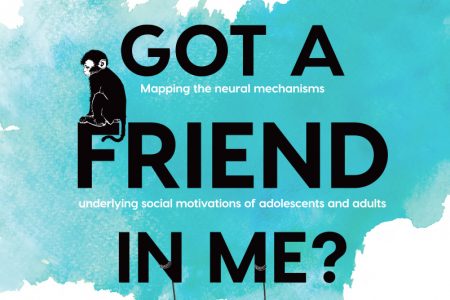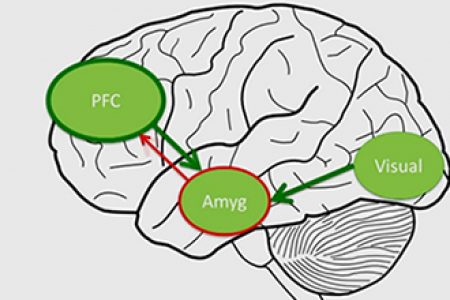Collaborative international open science in times of COVID: the start of my Rubicon project
A year ago, I received great news: I’d been awarded a Rubicon grant! This grant enabled me to work with Prof. Daniel Pine, based at the National Institute of Mental Health (US). But how could I perform an innovative, international scientific project in a pandemic?
Born to be shy?
Let’s start at the beginning: in my PhD project ‘Extremely Shy & Genetically Close’, I used MRI scans from socially anxious families to learn more about the innate vulnerability to developing social anxiety disorder (SAD). In my Rubicon application ‘Born to be shy?’, I chose another angle to explore why some children are ‘at risk’ for SAD, looking at an underlying temperamental trait. I focused on the neurobiological correlates of childhood inhibited temperament (cIT), as cIT is a stable and heritable trait, observable already early in life and associated with an elevated risk of developing SAD. Importantly, it is hypothesized that the foundation for cIT and the associated anxiety vulnerability may lie in brain characteristics, for example brain structure. Our knowledge concerning this ‘neural risk signature’ is still limited, as previous findings on the neurobiological underpinnings of IT are inconsistent, probably due to small sample sizes.
How could we advance our knowledge of this topic while the world was locked down? Here are two things I did to kick start the project.
1. Pool previously acquired data
When the project started in January 2021, travel to the US was not allowed, and the possibilities to acquire new data were limited. Therefore, I proposed bringing together multiple existing datasets– both MRI data and data on cIT – already collected in previous studies at research institutes worldwide.
This approach has multiple practical and scientific advantages. The first advantage is obvious: as on-site data acquisition was impossible, this decision enabled me to proceed with the project regardless of restrictions due to the COVID pandemic.
Second, re-using existing data-sets is not ‘second best’. Quite the contrary: I believe it’s very important to make the most of valuable research data, especially data from vulnerable participants (children and adolescents) who are often difficult to recruit.
Furthermore, pooling existing MRI data (which are costly to acquire) gave us the largest MRI sample related to cIT ever studied until now. We hope that performing a mega-analysis on this large dataset will enable us to detect novel cIT-related brain characteristics and will shed light on the inconsistent findings of previous studies. I perform this mega-analysis as part of the ENIGMA (Enhancing Neuro Imaging Genetics through Meta Analysis)-Anxiety working group, a worldwide consortium in which researchers collaborate in order to generate more robust and reproducible findings on brain characteristics of anxiety. Other studies within the ENIGMA consortium have yielded important insights into the neurobiology of psychopathology, underscoring the advantage of large-scale neuroimaging datasets. Of course, I hope my current project will also provide valuable insights, increasing our understanding of how psychopathology develops in young people at risk.
Last but not least, composing this large dataset enabled me to expand my international network, as I reached out to investigators worldwide and asked them to participate in the project. It’s a privilege to collaborate with so many researchers from all over the world.
2. Preregister study before the analyses
However, it can also be challenging to work with a large team of scientists and to involve them in the project when the only contact you have is by e-mail and online meetings. Therefore, I decided to use the ‘registered report’ approach. This entailed me writing the Introduction and Methods of my paper already, before I start the actual analysis this Fall. This ‘stage 1 submission’ is currently under review. Based on the reviewers’ comments, the journal (in our case JAACAP) can give me an ‘acceptance in principle’, which guarantees that they will accept the full paper (‘stage 2 submission’) regardless of the outcomes of the analysis. I see several important benefits of this approach.
First of all, preregistration of methods and hypotheses is increasingly considered part of good scientific ‘hypothetical-deductive’ research, as it has the potential to reduce publication bias; it minimizes the chances that the significance of the results will determine whether a paper is accepted (or rejected) for publication; and it increases the value of peer review, as suggestions of the reviewers on the proposed analyses can easily be implemented in the analysis.
Second, working on the Introduction and Methods of the paper at an early stage was a great way to involve all collaborators in the project and to think as a team about the possibilities for analyses before actually performing them.
Third, it enabled me to make good progress with the project while data-collection (i.e., composing the dataset for mega-analysis, which was in some cases complicated due to limited access to data in COVID times), was ongoing.
Next steps
Currently, I am waiting for the outcome of the peer-review process. I am very curious to read the comments of the reviewers (I hope they have interesting suggestions we can incorporate in our analyses!) and I am looking forward to seeing what the data will reveal. Of course, I will be more than happy to share the findings once we have them!
Note: this project is funded by a NWO Rubicon grant
(019.201SG.022) to Dr. Janna Marie Bas-Hoogendam





